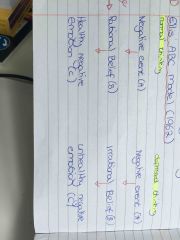![]()
![]()
![]()
Use LEFT and RIGHT arrow keys to navigate between flashcards;
Use UP and DOWN arrow keys to flip the card;
H to show hint;
A reads text to speech;
11 Cards in this Set
- Front
- Back
|
Depression |
A mood or affective disorder. It involves a prolonged and fundamental disturbance of mood and emotion. |
|
|
Emotional characteristics |
•Sadness/lowered mood. •Anger. •Loss of interest or pleasure in usual hobbies or activities. •Lowered self esteem |
|
|
Behavioural characteristics |
•Shift in activity levels,sleep,appetite and aggression. (Reduced or increased) |
|
|
Cognitive characteristics |
•Negative and irrational thoughts. •Poor concentration. •Dwelling on the negative. |
|
|
Cognitive explanations for depression |

Aaron Becks negative triad. Suggests that people create a negative schema leading to self ful filling prophecy. |
|
|
Ellis' ABC model |

A= activating event B= belief C= consequence |
|
|
Evaluation of ABC |
🙂-good supporting evidence ☹️- emotional are not always influenced by thoughts |
|
|
Cognitive behaviour therapy |
CBT aims to change the way a client thinks by challenging irrational thoughts. Focuses on Affect- how client feels Behaviour-how they act Cognition-how they think. |
|
|
Ellis' rational emotional behaviour therapy (REPT) |
A= activating event of adversity B= beliefs about event or adversity C= the emotional consequences D= disputations to challenge irrational beliefs E= effective new believes replace irrational ones F= feelings |
|
|
Evaluation of REPT and CBT |
🙂- it is effective ☹️- may not work for severe cases |
|
|
Advantages of cognitive explanations for depression |
🙂- based on sound experiments research. 🙂- provided effective research for depression. |

